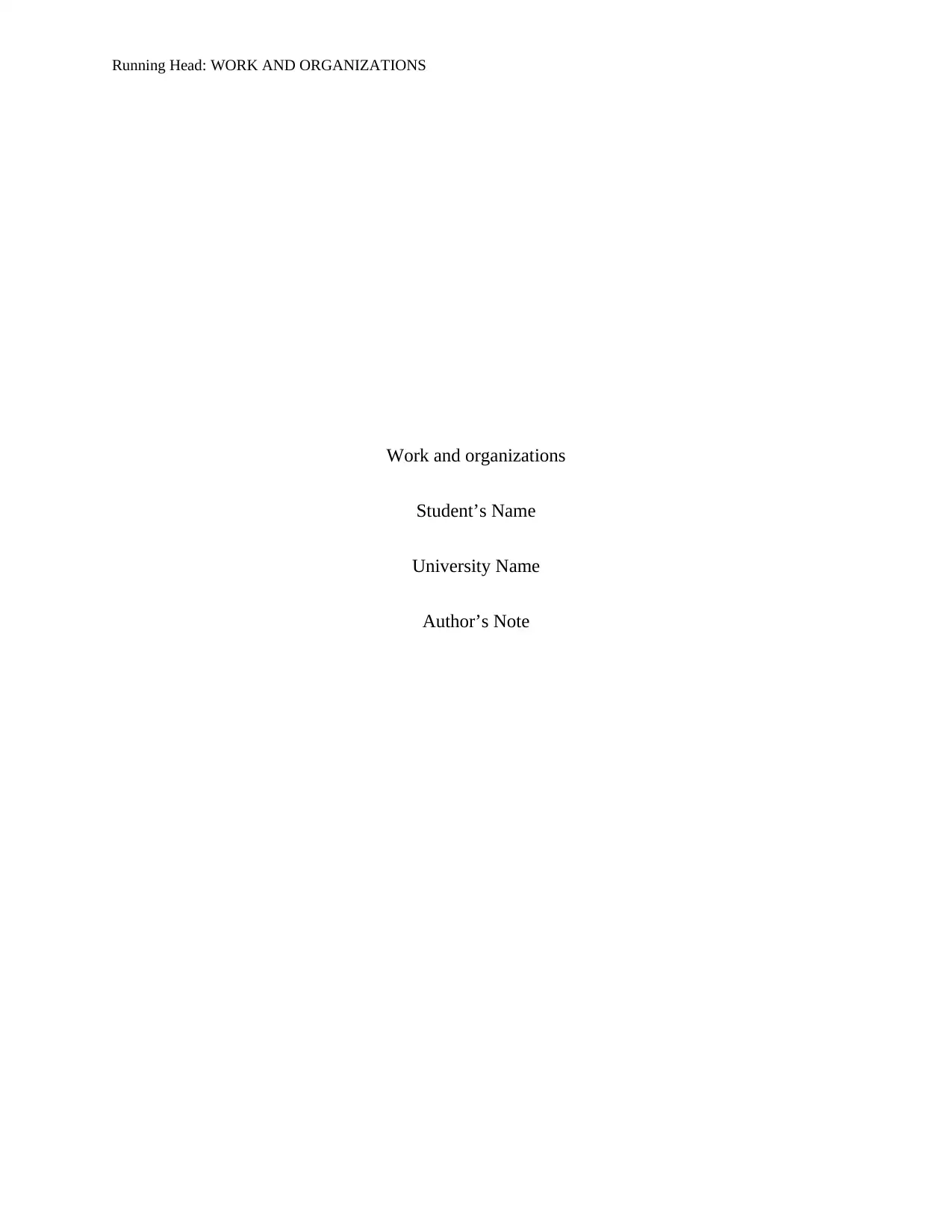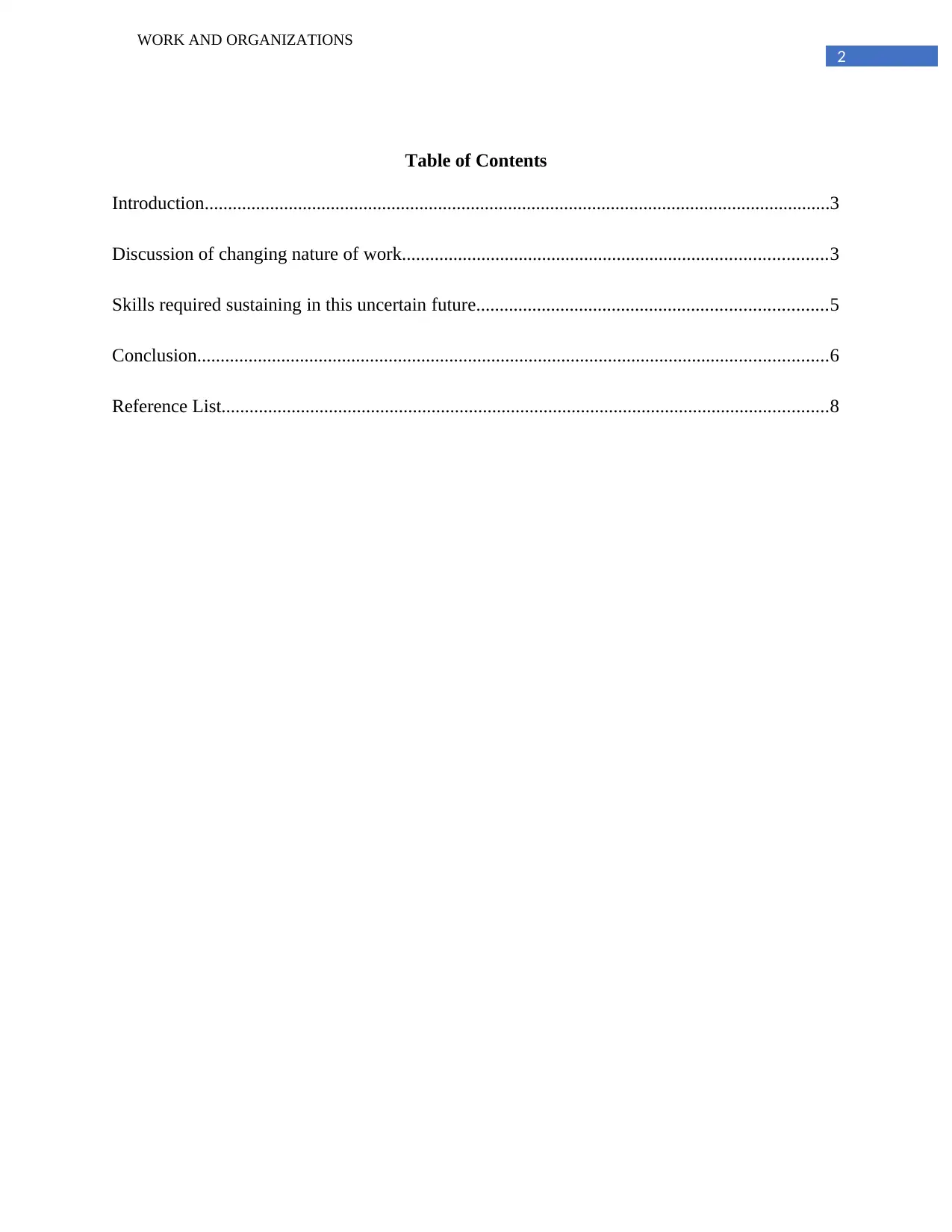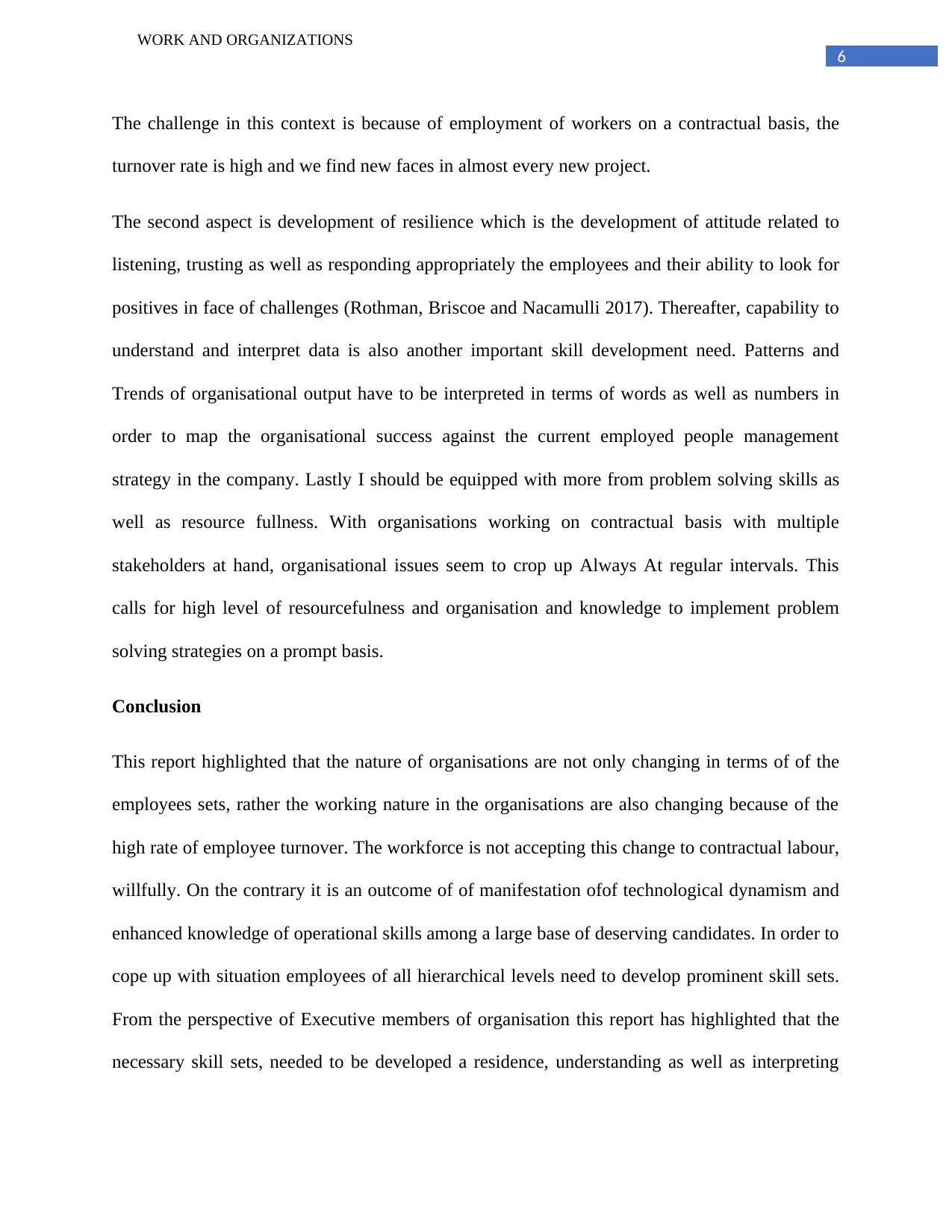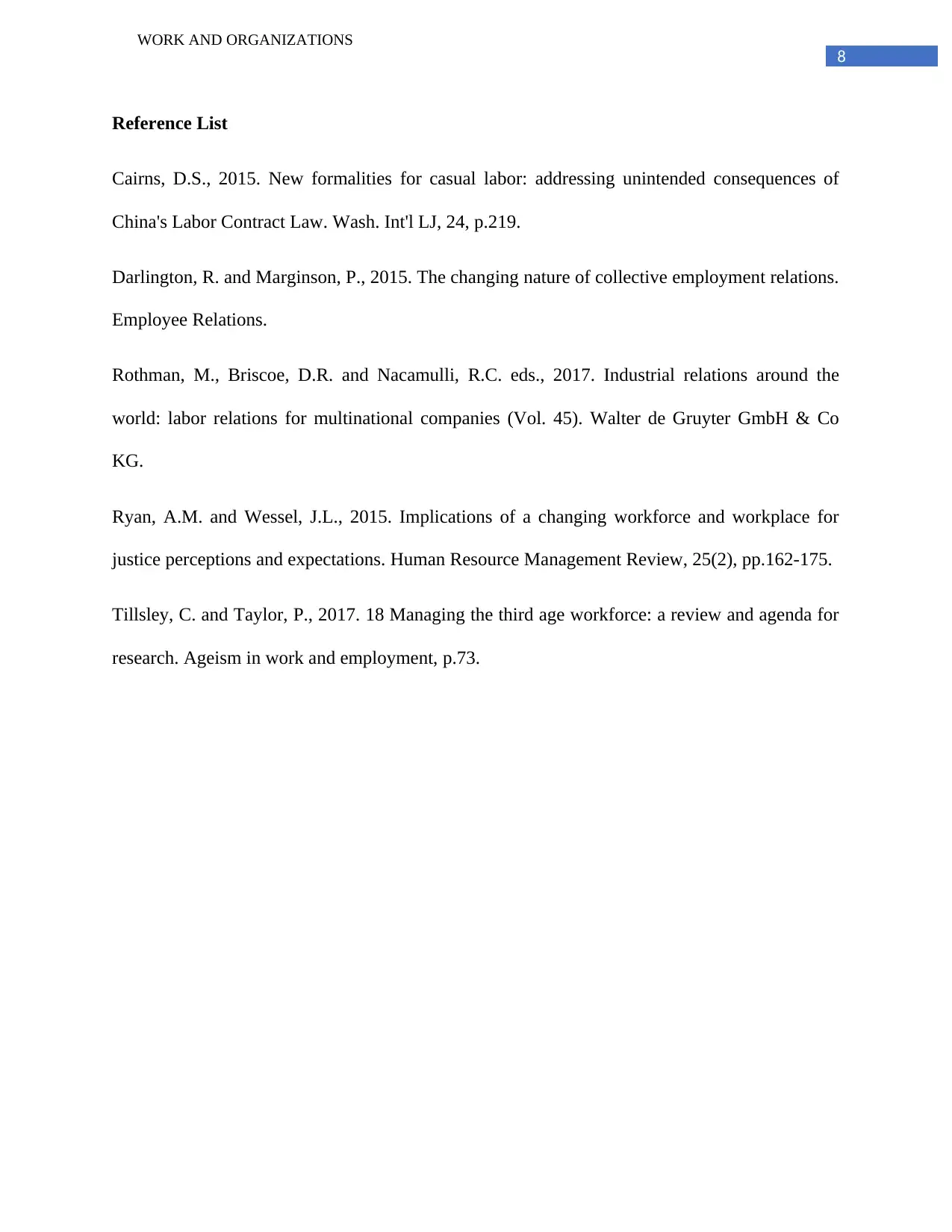Work and Organizations Report: Skills and Management Education
VerifiedAdded on 2022/09/27
|8
|1571
|35
Report
AI Summary
This report delves into the evolving landscape of work and organizations, examining the shift from traditional employment models to more flexible arrangements involving contractors, part-time workers, and remote employees. It highlights the impact of technological advancements and disruptive innovations on job roles and industries. The report critically discusses the implications for workplace skills, emphasizing the need for adaptability, emotional intelligence, resilience, data interpretation, and problem-solving abilities among executive members. It also explores the challenges of managing a diverse workforce and the importance of fostering employee engagement. Furthermore, the report analyzes the changing nature of work, emphasizing the necessity for management education to adapt to the evolving needs of the workforce and the changing nature of the workplace.

Running Head: WORK AND ORGANIZATIONS
Work and organizations
Student’s Name
University Name
Author’s Note
Work and organizations
Student’s Name
University Name
Author’s Note
Paraphrase This Document
Need a fresh take? Get an instant paraphrase of this document with our AI Paraphraser

2
WORK AND ORGANIZATIONS
Table of Contents
Introduction......................................................................................................................................3
Discussion of changing nature of work...........................................................................................3
Skills required sustaining in this uncertain future...........................................................................5
Conclusion.......................................................................................................................................6
Reference List..................................................................................................................................8
WORK AND ORGANIZATIONS
Table of Contents
Introduction......................................................................................................................................3
Discussion of changing nature of work...........................................................................................3
Skills required sustaining in this uncertain future...........................................................................5
Conclusion.......................................................................................................................................6
Reference List..................................................................................................................................8

3
WORK AND ORGANIZATIONS
Introduction
This report concerns the changing nature of work places. The background study refers to the fact
that rather than predominantly stable staff line in organizations, the word forces of today
comprise of less full-time employees and more contractual staff with shared roles and casual
workers employed on temporary demand basis. In light of the above context, this research study
will discuss the issues in workplaces and other predictable changes that apprehended in the next
5 to 10 years to occur. Under the change conditions, the implications for workers as well as
executive staff organizations will also be discussed. In the last section the personal skill sets that
will be essential for sustaining in this futuristic atmosphere will also be discussed.
Discussion of changing nature of work
The momentum of connectivity as well as cognitive technology is changing the nature of work,
in the recent times. Steadiness in progress as well as refinement has been observed under the
presence of cognitive Technologies as well as artificial intelligence. This emphasizes a strong
need for Change management in Enterprises and requires the HR leaders to preemt, design as
well as manage the futuristic workplaces and work cultures accordingly. Lot of changes are
affecting the workplaces and even more drastic changes are supposedly coming in the upcoming
5 to 10 years. The first crucial thing is technical change with the introduction of Technologies
like mobility, web conferencing, telepresence, cloud computing and so on. These features are
powering connectivity throughout the globe alongside allowing people to work remotely.
Naturally, this is reducing the importance of a stable workforce with permanent working
members (Ryan and Wessel 2015). The organizations are getting the opportunity to utilize the
capability of people without having to invest their resources for recruiting them. People need not
come to officers, and hence they can be easily employed for one or two contractual projects with
WORK AND ORGANIZATIONS
Introduction
This report concerns the changing nature of work places. The background study refers to the fact
that rather than predominantly stable staff line in organizations, the word forces of today
comprise of less full-time employees and more contractual staff with shared roles and casual
workers employed on temporary demand basis. In light of the above context, this research study
will discuss the issues in workplaces and other predictable changes that apprehended in the next
5 to 10 years to occur. Under the change conditions, the implications for workers as well as
executive staff organizations will also be discussed. In the last section the personal skill sets that
will be essential for sustaining in this futuristic atmosphere will also be discussed.
Discussion of changing nature of work
The momentum of connectivity as well as cognitive technology is changing the nature of work,
in the recent times. Steadiness in progress as well as refinement has been observed under the
presence of cognitive Technologies as well as artificial intelligence. This emphasizes a strong
need for Change management in Enterprises and requires the HR leaders to preemt, design as
well as manage the futuristic workplaces and work cultures accordingly. Lot of changes are
affecting the workplaces and even more drastic changes are supposedly coming in the upcoming
5 to 10 years. The first crucial thing is technical change with the introduction of Technologies
like mobility, web conferencing, telepresence, cloud computing and so on. These features are
powering connectivity throughout the globe alongside allowing people to work remotely.
Naturally, this is reducing the importance of a stable workforce with permanent working
members (Ryan and Wessel 2015). The organizations are getting the opportunity to utilize the
capability of people without having to invest their resources for recruiting them. People need not
come to officers, and hence they can be easily employed for one or two contractual projects with
⊘ This is a preview!⊘
Do you want full access?
Subscribe today to unlock all pages.

Trusted by 1+ million students worldwide

4
WORK AND ORGANIZATIONS
a payment on agreement basis. Considering the fact that the competition in job market has
increased severely, these contractual offers are proactively accepted by educated youth who are
seeking jobs. Infection organizations employ people on contractual basis, who have not yet
graduated or still pursuing basic levels of Higher Education. The next time of change is spatial
change. Under this changed criteria employees are not confined to office faces and knowledge
sharing then take place anytime, anywhere. In the upcoming 5 years this exchange of knowledge
will happen at an even faster rate with Internet devices becoming more accessible (Darlington
and Marginson 2015). Development of software along with operational knowledge is increasing
the availability of working professionals. This is providing technological competence because of
which the emerging organizations are not suffering from lack of professionals. Observing this
situation, Tillsley and Taylor (2017), analysed that the candidates are looking for employers
providing the maximum compensation and on the other hand the organisations are also looking
for candidates to hire against minimum wage rate. As an outcome, employees are not satisfied
with a single organisation and they are constantly looking out for alternatives. This brings in the
demand for casual, contemporary and contractual workers. There have been specific aptitude
changes also since work has become complex and work procedures are changing at great pace. In
context to global connectivity, work is taking place across broad base of settings common
geographies as well as timeframes that needs high level of collaboration, teamwork as well as
social skills.
In this context, it can be happy and it that all the organisations are relying much more on
contractual or temporary workers, however in the time to come this will lead to severe challenges
also. Contractual labour force implies that they will have lesser attachment with the
organisational goals and thereby their approach towards organisational communication would
WORK AND ORGANIZATIONS
a payment on agreement basis. Considering the fact that the competition in job market has
increased severely, these contractual offers are proactively accepted by educated youth who are
seeking jobs. Infection organizations employ people on contractual basis, who have not yet
graduated or still pursuing basic levels of Higher Education. The next time of change is spatial
change. Under this changed criteria employees are not confined to office faces and knowledge
sharing then take place anytime, anywhere. In the upcoming 5 years this exchange of knowledge
will happen at an even faster rate with Internet devices becoming more accessible (Darlington
and Marginson 2015). Development of software along with operational knowledge is increasing
the availability of working professionals. This is providing technological competence because of
which the emerging organizations are not suffering from lack of professionals. Observing this
situation, Tillsley and Taylor (2017), analysed that the candidates are looking for employers
providing the maximum compensation and on the other hand the organisations are also looking
for candidates to hire against minimum wage rate. As an outcome, employees are not satisfied
with a single organisation and they are constantly looking out for alternatives. This brings in the
demand for casual, contemporary and contractual workers. There have been specific aptitude
changes also since work has become complex and work procedures are changing at great pace. In
context to global connectivity, work is taking place across broad base of settings common
geographies as well as timeframes that needs high level of collaboration, teamwork as well as
social skills.
In this context, it can be happy and it that all the organisations are relying much more on
contractual or temporary workers, however in the time to come this will lead to severe challenges
also. Contractual labour force implies that they will have lesser attachment with the
organisational goals and thereby their approach towards organisational communication would
Paraphrase This Document
Need a fresh take? Get an instant paraphrase of this document with our AI Paraphraser

5
WORK AND ORGANIZATIONS
also be casual (Cairns 2015). Informal approach to work practices, which is a generic
development in recent times will also disturb work ethics and determination to achieve
organisational goals. In order to ensure that the individual workers do not take their work likely
and give their maximum effort towards the professional objectives of the company, individual
work goals are segregated and allocated to them by executive members of the organisation.
Because of this approach, the workforce never feels integrated with the business objectives of the
company and exhibits least tendency to collaborate for better organisational outcomes.
As such in order to ensure a combination between workers, work as well as workplaces,
organisations are encouraging socialization and Enterprises are leading more HR management
members and workplace practices with conscious organisational Strategies for efficient
establishment of link between employees (Rothman, Briscoe and Nacamulli 2017). In the first
race, it can be observed that employee engagement is not able to reduce the turnover rate of
organisations which implies that engagement with organisations has not enhanced in respective
of the typical strategic approaches of HR management to enhance Association of employees.
Skills required sustaining in this uncertain future
Analysing the typical changes in the Global working sphere, with the predominant change being
a gradual transition from a stable and competitive workforce to employee base with casual and
contractual workers on a contractual project basis, I believe that as an executive member of the
organization I also need to develop some unique skill sets in order to adopt with the changing
atmosphere. Firstly I need to develop adaptability towards new situations in environment is the
new requirement where the executive have to undergo operations with various new operational
members. This is why I suppose I have to develop my emotional intelligence and I am Pacific
nature so that I am able to understand the personal and professional requirements of teammates.
WORK AND ORGANIZATIONS
also be casual (Cairns 2015). Informal approach to work practices, which is a generic
development in recent times will also disturb work ethics and determination to achieve
organisational goals. In order to ensure that the individual workers do not take their work likely
and give their maximum effort towards the professional objectives of the company, individual
work goals are segregated and allocated to them by executive members of the organisation.
Because of this approach, the workforce never feels integrated with the business objectives of the
company and exhibits least tendency to collaborate for better organisational outcomes.
As such in order to ensure a combination between workers, work as well as workplaces,
organisations are encouraging socialization and Enterprises are leading more HR management
members and workplace practices with conscious organisational Strategies for efficient
establishment of link between employees (Rothman, Briscoe and Nacamulli 2017). In the first
race, it can be observed that employee engagement is not able to reduce the turnover rate of
organisations which implies that engagement with organisations has not enhanced in respective
of the typical strategic approaches of HR management to enhance Association of employees.
Skills required sustaining in this uncertain future
Analysing the typical changes in the Global working sphere, with the predominant change being
a gradual transition from a stable and competitive workforce to employee base with casual and
contractual workers on a contractual project basis, I believe that as an executive member of the
organization I also need to develop some unique skill sets in order to adopt with the changing
atmosphere. Firstly I need to develop adaptability towards new situations in environment is the
new requirement where the executive have to undergo operations with various new operational
members. This is why I suppose I have to develop my emotional intelligence and I am Pacific
nature so that I am able to understand the personal and professional requirements of teammates.

6
WORK AND ORGANIZATIONS
The challenge in this context is because of employment of workers on a contractual basis, the
turnover rate is high and we find new faces in almost every new project.
The second aspect is development of resilience which is the development of attitude related to
listening, trusting as well as responding appropriately the employees and their ability to look for
positives in face of challenges (Rothman, Briscoe and Nacamulli 2017). Thereafter, capability to
understand and interpret data is also another important skill development need. Patterns and
Trends of organisational output have to be interpreted in terms of words as well as numbers in
order to map the organisational success against the current employed people management
strategy in the company. Lastly I should be equipped with more from problem solving skills as
well as resource fullness. With organisations working on contractual basis with multiple
stakeholders at hand, organisational issues seem to crop up Always At regular intervals. This
calls for high level of resourcefulness and organisation and knowledge to implement problem
solving strategies on a prompt basis.
Conclusion
This report highlighted that the nature of organisations are not only changing in terms of of the
employees sets, rather the working nature in the organisations are also changing because of the
high rate of employee turnover. The workforce is not accepting this change to contractual labour,
willfully. On the contrary it is an outcome of of manifestation ofof technological dynamism and
enhanced knowledge of operational skills among a large base of deserving candidates. In order to
cope up with situation employees of all hierarchical levels need to develop prominent skill sets.
From the perspective of Executive members of organisation this report has highlighted that the
necessary skill sets, needed to be developed a residence, understanding as well as interpreting
WORK AND ORGANIZATIONS
The challenge in this context is because of employment of workers on a contractual basis, the
turnover rate is high and we find new faces in almost every new project.
The second aspect is development of resilience which is the development of attitude related to
listening, trusting as well as responding appropriately the employees and their ability to look for
positives in face of challenges (Rothman, Briscoe and Nacamulli 2017). Thereafter, capability to
understand and interpret data is also another important skill development need. Patterns and
Trends of organisational output have to be interpreted in terms of words as well as numbers in
order to map the organisational success against the current employed people management
strategy in the company. Lastly I should be equipped with more from problem solving skills as
well as resource fullness. With organisations working on contractual basis with multiple
stakeholders at hand, organisational issues seem to crop up Always At regular intervals. This
calls for high level of resourcefulness and organisation and knowledge to implement problem
solving strategies on a prompt basis.
Conclusion
This report highlighted that the nature of organisations are not only changing in terms of of the
employees sets, rather the working nature in the organisations are also changing because of the
high rate of employee turnover. The workforce is not accepting this change to contractual labour,
willfully. On the contrary it is an outcome of of manifestation ofof technological dynamism and
enhanced knowledge of operational skills among a large base of deserving candidates. In order to
cope up with situation employees of all hierarchical levels need to develop prominent skill sets.
From the perspective of Executive members of organisation this report has highlighted that the
necessary skill sets, needed to be developed a residence, understanding as well as interpreting
⊘ This is a preview!⊘
Do you want full access?
Subscribe today to unlock all pages.

Trusted by 1+ million students worldwide

7
WORK AND ORGANIZATIONS
data, communication and networking, problem solving as well as resource fullness and lastly
responsibility for learning you are Strategies for employee management.
WORK AND ORGANIZATIONS
data, communication and networking, problem solving as well as resource fullness and lastly
responsibility for learning you are Strategies for employee management.
Paraphrase This Document
Need a fresh take? Get an instant paraphrase of this document with our AI Paraphraser

8
WORK AND ORGANIZATIONS
Reference List
Cairns, D.S., 2015. New formalities for casual labor: addressing unintended consequences of
China's Labor Contract Law. Wash. Int'l LJ, 24, p.219.
Darlington, R. and Marginson, P., 2015. The changing nature of collective employment relations.
Employee Relations.
Rothman, M., Briscoe, D.R. and Nacamulli, R.C. eds., 2017. Industrial relations around the
world: labor relations for multinational companies (Vol. 45). Walter de Gruyter GmbH & Co
KG.
Ryan, A.M. and Wessel, J.L., 2015. Implications of a changing workforce and workplace for
justice perceptions and expectations. Human Resource Management Review, 25(2), pp.162-175.
Tillsley, C. and Taylor, P., 2017. 18 Managing the third age workforce: a review and agenda for
research. Ageism in work and employment, p.73.
WORK AND ORGANIZATIONS
Reference List
Cairns, D.S., 2015. New formalities for casual labor: addressing unintended consequences of
China's Labor Contract Law. Wash. Int'l LJ, 24, p.219.
Darlington, R. and Marginson, P., 2015. The changing nature of collective employment relations.
Employee Relations.
Rothman, M., Briscoe, D.R. and Nacamulli, R.C. eds., 2017. Industrial relations around the
world: labor relations for multinational companies (Vol. 45). Walter de Gruyter GmbH & Co
KG.
Ryan, A.M. and Wessel, J.L., 2015. Implications of a changing workforce and workplace for
justice perceptions and expectations. Human Resource Management Review, 25(2), pp.162-175.
Tillsley, C. and Taylor, P., 2017. 18 Managing the third age workforce: a review and agenda for
research. Ageism in work and employment, p.73.
1 out of 8
Related Documents
Your All-in-One AI-Powered Toolkit for Academic Success.
+13062052269
info@desklib.com
Available 24*7 on WhatsApp / Email
![[object Object]](/_next/static/media/star-bottom.7253800d.svg)
Unlock your academic potential
Copyright © 2020–2025 A2Z Services. All Rights Reserved. Developed and managed by ZUCOL.





